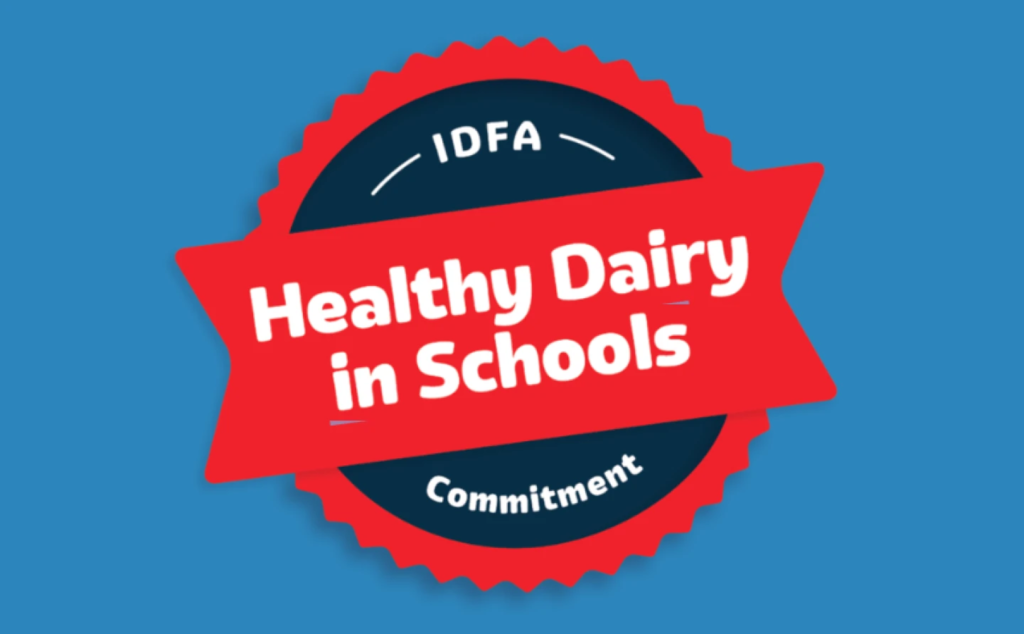Through the Healthy Dairy in Schools Commitment, the dairy industry is pledging to remove certified artificial colors from milk, cheese and yogurt served in K-12 school meals by July 2026.
Dairy companies are making a new move to better support child nutrition by pledging to remove certified artificial colors from the dairy products they provide to schools. Through its new Healthy Dairy in Schools Commitment, the International Dairy Foods Association (IDFA) is rallying the industry around a voluntary effort to ensure milk, cheese and yogurt served in K-12 school meals are free from synthetic dyes by July 2026. The pledge aims to impact meals served to 30 million students through the National School Lunch and Breakfast Programs.

“The Healthy Dairy in Schools Commitment goes above and beyond state and federal regulations to help ensure children in grades K-12 continue to have access to the milk, cheese and yogurt options they enjoy without any certified artificial colors,” says Michael Dykes, DVM, IDFA president and CEO.
U.S. Secretary of Agriculture Brooke Rollins praises the move, calling it an example of industry-led progress.
“America’s dairy farmers and milk processors have always led the way in providing our families and schoolchildren with healthy, nutritious and delicious milk products. While I look forward to getting whole milk back into our schools, today’s announcement shows how the dairy industry is voluntarily driving change and giving consumers what they want, without government mandates,” she says. “I thank IDFA and the dairy industry for leading the way and look forward to other industries thinking about how, together, we can make America healthy again.”
While most dairy products served in schools already steer clear of artificial colors, this pledge brings consistency across the board and positions dairy ahead of a shifting regulatory landscape, as more states introduce bans on such ingredients.
Read More: FSSAI Cracks Down on Online Grocery Platforms Over Expiry Date
“There are so many health benefits associated with dairy, and we need to hang on to those,” says Matt Herrick, executive vice president and chief impact officer at IDFA. “We don’t want any disruption. We saw disruption on the horizon if we didn’t get proactive and aggressive, and we’re really trying to protect the products that we do have in schools.”
According to Herrick, less than 10% of school-served dairy products currently contain artificial colors.
“So, it’s not a big lift for the dairy industry to remove or change the ingredients for the products that do,” he adds.
That industrywide momentum, he explains, is what makes this initiative both practical and powerful.
“Food companies and processors who sell any dairy products to schools are all supportive of this effort,” Herrick says. “They either don’t sell products with artificial colors, or they will reformulate their products that do with natural ingredients — often with beet, carrot or watermelon powder or a fruit or vegetable juice.”
He also emphasizes dairy’s reputation with consumers.
“Dairy is found in 93% to 95% of households in the U.S.,” he says. “We are a staple and well loved by consumers, so we really want to ensure that consumers, especially parents or anyone who is caring for a child, looks at dairy and perceives it as a wholesome, healthy food as an option for their family that can be served at all meal occasions.”
Building on that strong foundation of trust and familiarity, Herrick emphasizes the importance of maintaining dairy’s positive reputation — especially among families making daily food choices.
“The Healthy Dairy in Schools Commitment was [a] proactive measure to take a step so we would continue to be seen in that positive light by those consumers, especially by parents,” he says. “We want kids to love [dairy] because they are the next generation of dairy consumers or purchasers. So that means making sure that these products remain available to kids.”
To preserve that trust and ensure long-term consumer confidence, Herrick says the industry saw an opportunity to act early and collaboratively.
“We felt like we could make this move and be proactive,” he continues. “We can be proactive and make a small change like this and replace it with natural ingredients, which most of the companies use anyway. It seemed like a small move to make for a big, big dividend down the line.”
Join Our “Dairy & Food Jobs Updates” WhatsApp group
Stay informed on all the latest news updates
All Agriculture Books Free Download
All Dairy Technology Books Free Download
All Agricultural Engineering Books Free download
All Horticulture Books Free Download
All Fisheries Science Books Free Download
For Daily Update follow us at:
Facebook Telegram Whatsapp Instagram YouTube
The contents are provided free for noncommercial purpose such as teaching, training, research, extension and self learning.
If you are facing any Problem than fill form Contact Us
If you want share any article related Agriculture with us than send at info@agrimoon.com with your contact detail.


